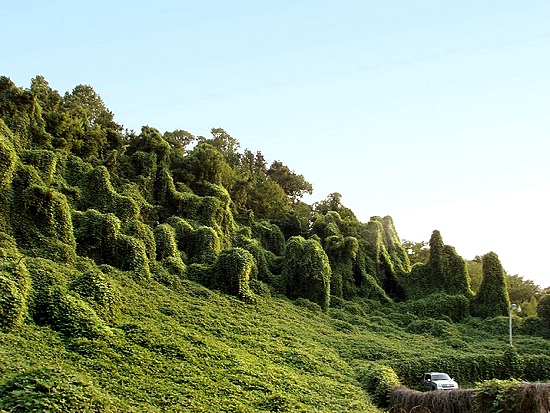Kudzu: Scourge of the South
It’s known as the “plant that ate the South.” Where did it come from, and how do we kill it?

Kudzu can grow up to one foot in length in a day. That’s pretty awesome.
Except not really.
“This is really terrible,” said Peggy Singlemann, Director of Horticulture at Maymont and co-host of WCVE’s Virginia Home Grown radio show, about kudzu. “People don’t realize what it’s doing.”
So what’s it doing?
Oh, only just killing ecosystems across the Southeast. “This is a nuisance to our forests and our woodlands because it truly blankets the trees and blankets the ground and completely kills any of our native plants,” Singlemann said. “If you’re coating the ground with kudzu and killing everything, you’re destroying a whole ecosystem. And that’s what kudzu does: it destroys and kills a whole ecosystem.”
That’s one reason, she said, why birds and insects populations have diminished over the years.
Kudzu roots can grow 15 feet deep into the ground “easily” (!) and its roots “can go from a half-inch diameter up to four inches in diameter,” Singlemann said. “And 30 vines can sprout off of that [single] root.”
What’s become known as the Scourge of the South was once heralded as agricultural boon before it became an agricultural menace.
Wow this stuff is great…jk!
“Kudzu is a vine that native to Japan,” Singlemann said. “It was introduced through the 100th anniversary celebration of the United States at the 1876 Centennial Celebration in Philadelphia” when Japan built a teahouse with a stunning garden that happened to feature their native vine.
“It just took America by storm,” Singlemann said. “It was first used as an ornamental plant, and then it was discovered to be a great erosion-control plant.”
Farmers during the Dust Bowl of the 1930s used the vine because of its rapid growth and durability in harsh agricultural conditions. The Civilian Conservation Corps (CCC), created under Franklin Roosevelt’s New Deal program, even used the plant it to control severely eroded areas across the country.
But the invasiveness of the vine eventually creeped up on Americans when they realized that getting rid of the stuff was nearly impossible. “And so by the early 1950s, it was banned as an invasive plant not to be used ever again,” Singlemann said. “Not to be planted; not to be encouraged to be planted.”
But the damage was already done
Come in. Make yourself comfortable
Kudzu thrives in the Southeast and is even called the “plant that ate the South.”
“It has really commanded–and I want to say blanketed in some areas–the Eastern US,” Singlemann said. “Unfortunately, the Southeast corner of the United States has the absolute perfect growing conditions1 for this vine.” High humidity, relatively warm winters, hot summers, and over 40” of rain annually make the vine feel right at home.
It’s not surprising that people have found several uses for the vine that won’t go away. “There are dishes made out of kudzu. You can make baskets out of it. Some people make various kudzu jams and jellies. Some people make kudzu honey,” Singlemann said.
Ages ago, the Japanese and Chinese used the plant for medicinal means. “It’s actually being tested for some medicinal values now by the USDA,” Singlemann said.
But how do we get rid of it?
Persistence.
“When I came to Maymont, we had kudzu on one hillside. It took me three years to eradicate that kudzu…three years to kill that stuff,” Singlemann said. “I know that if I didn’t, I could actually lose half of Maymont to it.”
Whereas Japan and China have insects and environmental factors to control the vine’s growth, the Southeast doesn’t. “There’s no magic bullet for this,” Singlemann said.
Above all, she advises people that have kudzu on the property ensure it doesn’t flower. “In there are kidney-shaped beans2…that can stay viable for years,” Singlemann said. “You don’t want those seeds to be dropped and just lay there in the soil waiting for the perfect conditions to germinate.”
The first step to killing kudzu is clear away what’s above ground. “You’ve got to get down and take off the layer of the vine so that you can get down to managing the root,” Singlemann said. “Consistently and persistently cutting it will actually use up all the stored carbohydrates in the roots, and you will exhaust the roots and kill them.” A process that, again, took Singlemann three years to accomplish.
She warns people to not put kudzo in a compost pile, but to bag it and drop it off at the dump. “Because if they put it in their compost pile, it’s just going to root.”
Besides manual labor and persistence, the only natural way to deal with kudzu is to have goats or cows continually graze on the stuff.3 Not a great option for those living in the city.
Although always hesitant to use and recommend herbicides, Singlemann said glyphosate4 has been proven successful at killing kudzu…but over time and with regular application.
“Persistence. It’ll get it,” Singlemann said. “You can do it. But it’s not going to be easy.”
photo by Katie Ashdown
-
Although climate change means the vine is now moving north.
-
It’s in the legume family.
-
A job for the Goat Busters that recently cleared a portion of Chimborazo Park!
-
Roundup is the Monsanto formulation.
-
Recommend this
on Facebook -

Report an error
-

Subscribe to our
Weekly Digest






There are no reader comments. Add yours.